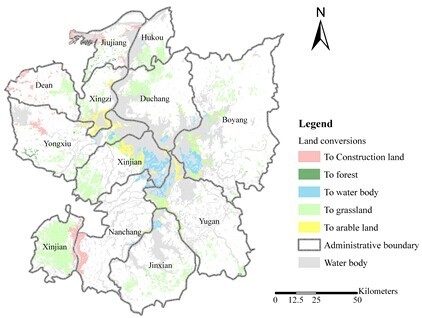A Spatial Optimization Model for Sustainable Land Use at Regional Level in China: A Case Study for Poyang Lake Region
Abstract
:1. Introduction
2. Land-Use Master Planning in China
3. A Land-Use Optimization Model
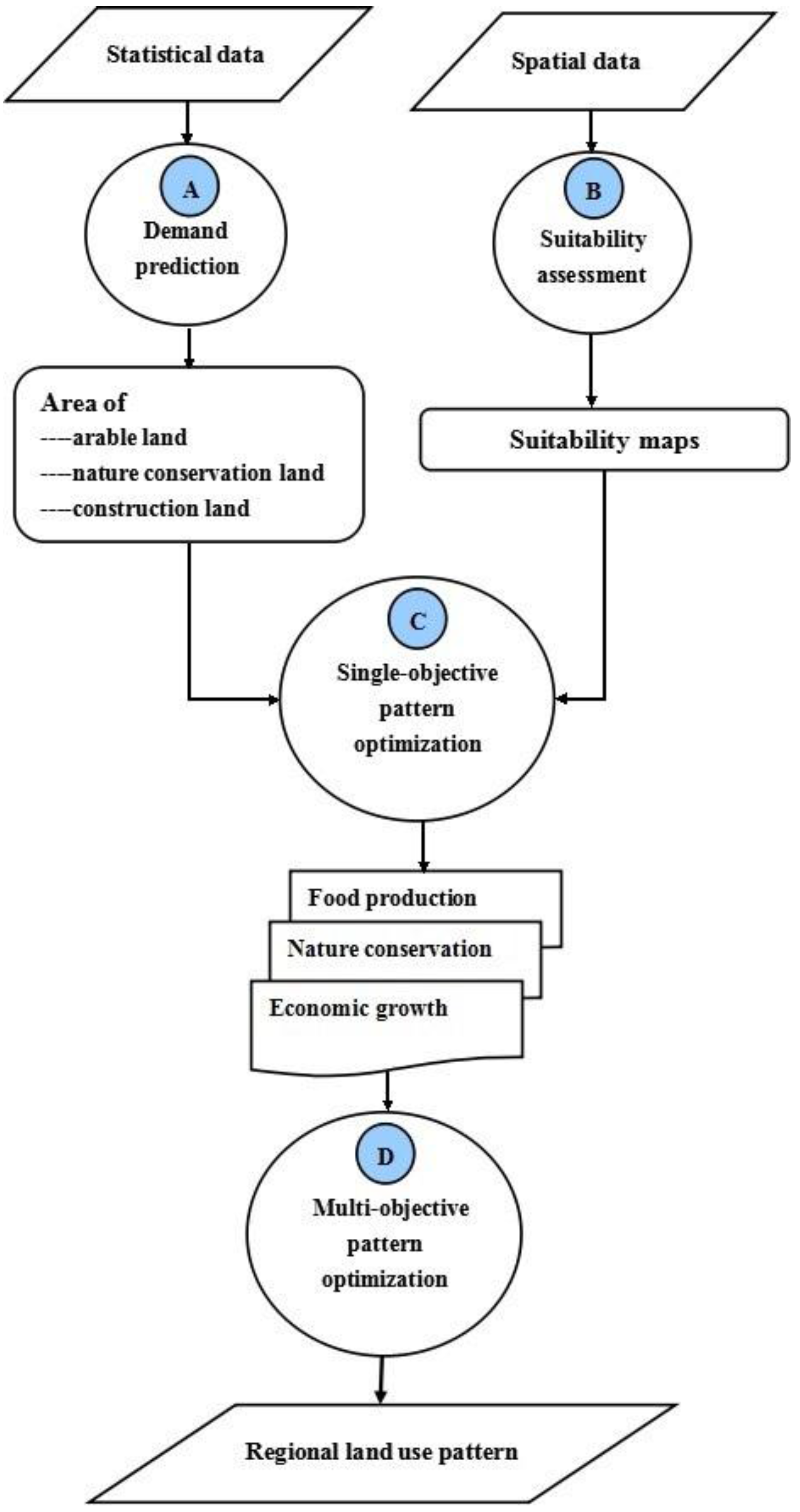
3.1. Step A Demand Prediction
3.2. Step B Suitability Assessment
| Limiting factors | Limiting class | Suitability class of each land use | ||||
|---|---|---|---|---|---|---|
| code | classification criterion | Paddy field | Dry land | Forest land | Grassland | |
| Slope (P) | P0 | <2° | 1 | 1 | 1 | 1 |
| P1 | 2°–5° | 2 | 1 | 1 | 1 | |
| P2 | 5°–15° | 2 | 2 | 1 | 2 | |
| P3 | 15°–25° | 3 | 3 | 2 | 3 | |
| P4 | >25° | 4 | 4 | 3 | 4 | |
| Soil parent material (R) | R0 | sediment | 1 | 1 | 1 | 1 |
| R1 | Limestone/sandstone | 2 | 2 | 1 | 1 | |
| R2 | conglomerate | 3 | 3 | 2 | 3 | |
| R3 | carbonatite | 4 | 3 | 2 | 3 | |
| Soil organic matter (O) | O0 | >3% | 1 | 1 | 1 | 1 |
| O1 | 2%–3% | 2 | 1 | 1 | 1 | |
| O2 | 1%–2% | 3 | 2 | 2 | 2 | |
| O3 | 0.6%–1% | 4 | 3 | 2 | 3 | |
| O4 | <0.6% | 4 | 4 | 3 | 4 | |
| Landform (T) | T0 | plain | 1 | 1 | 1 | 1 |
| T1 | Sloping-land | 2 | 2 | 1 | 1 | |
| T2 | Low-hill | 2 | 2 | 1 | 1 | |
| T3 | High-hill | 3 | 3 | 2 | 2 | |
| T4 | Low-mountain | 4 | 4 | 2 | 2 | |
| T5 | Moderate-mountain | 4 | 4 | 3 | 3 | |
3.3. Step C Single-Objective Pattern Optimization
| To | Arable land | Forest | |
|---|---|---|---|
| From | |||
| Arable land | N.A. | Unsuitable for arable land; | |
| High suitability for forest; | |||
| Low ecosystem robustness; | |||
| Landform: Mountain | |||
| Non-developed land | High or moderate suitability for arable land; Low or moderate flood risk | N.A. | |
| To | Forest | Grassland | Water | |
|---|---|---|---|---|
| From | ||||
| Arable land | Unsuitable for arable land; High suitability for forest; Landform: mountain | Unsuitable for arable land; High suitability for grassland | Unsuitable for arable land; | |
| Distance to lake <500 m; | ||||
| Slope 0–2°; | ||||
| Landform: plain | ||||
| Forest | N.A. | N.A. | Unsuitable or low suitability for forest; | |
| Distance to lake <500 m; | ||||
| Slope 0–2°; | ||||
| Landform: plain | ||||
| Grassland | N.A. | N.A. | Unsuitable or low suitability for grassland; | |
| Distance to lake <500 m; | ||||
| Slope 0–2° | ||||
| Landform: plain | ||||
| Non-developed land | High or moderate suitability for forest; Landform: mountain | High or moderate suitability for grassland | Distance to lake <500 m; | |
| Slope 0–2°; | ||||
| Landform: plain | ||||
| To | Construction land | |
|---|---|---|
| From | ||
| Arable land | Unsuitable for arable land; | |
| High economic growth rate; | ||
| Landform: plain, lowland or lower hilly land | ||
| Grassland | Unsuitable or low suitability for grassland; | |
| High or comparatively high economic growth rate; | ||
| Landform: plain, lowland or lower hilly land | ||
| Forest | Unsuitable or low suitability for forest; | |
| High or comparatively high economic growth rate; | ||
| Landform: plain, lowland or lower hilly land | ||
| Non-developed land | High or comparatively high economic growth rate; | |
| Landform: plain, lowland or lower hilly land | ||
3.4. Step D Multi-Objective Pattern Optimization
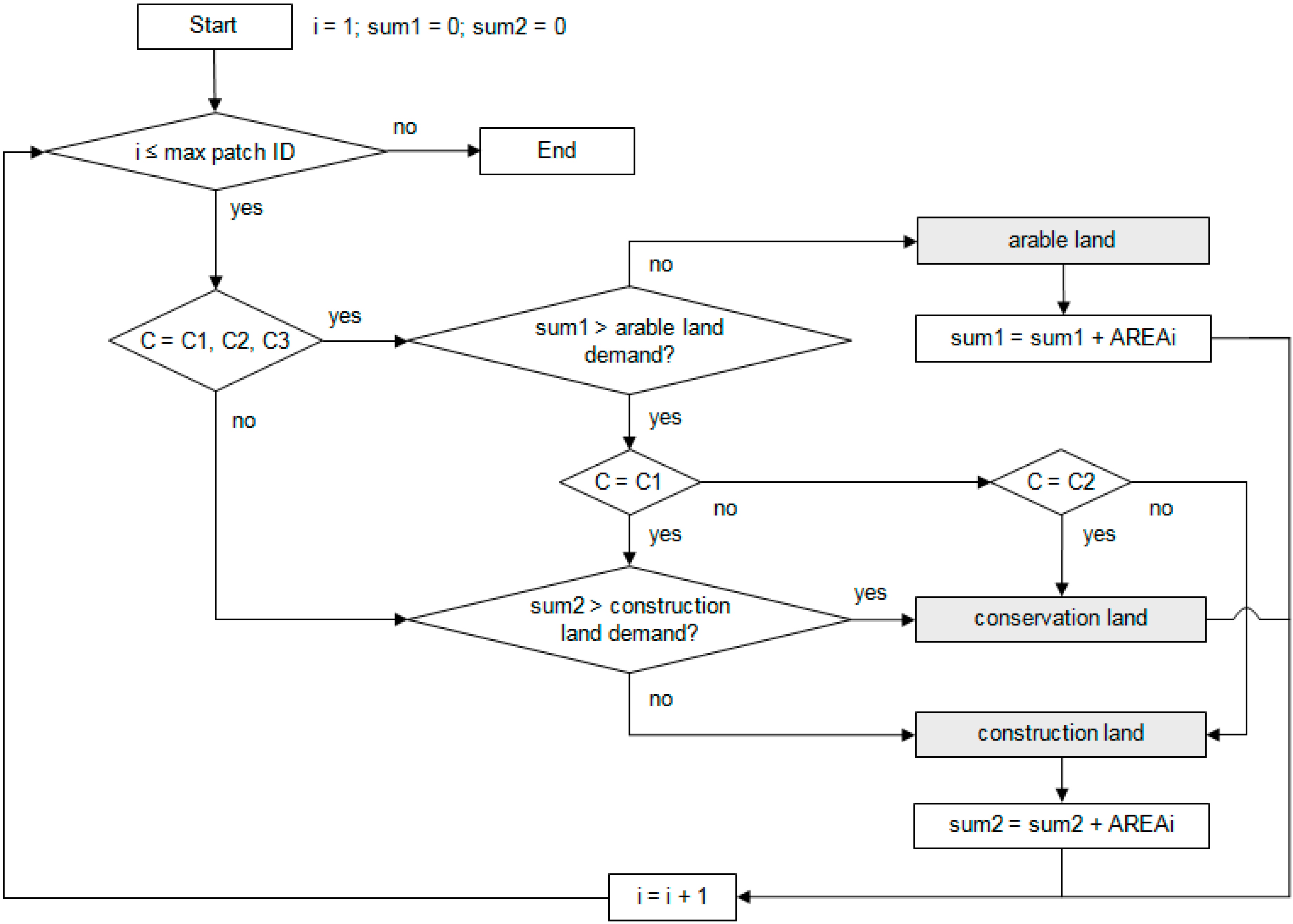
3.5. Model Assessment
4. Case Study Area: Poyang Lake Region
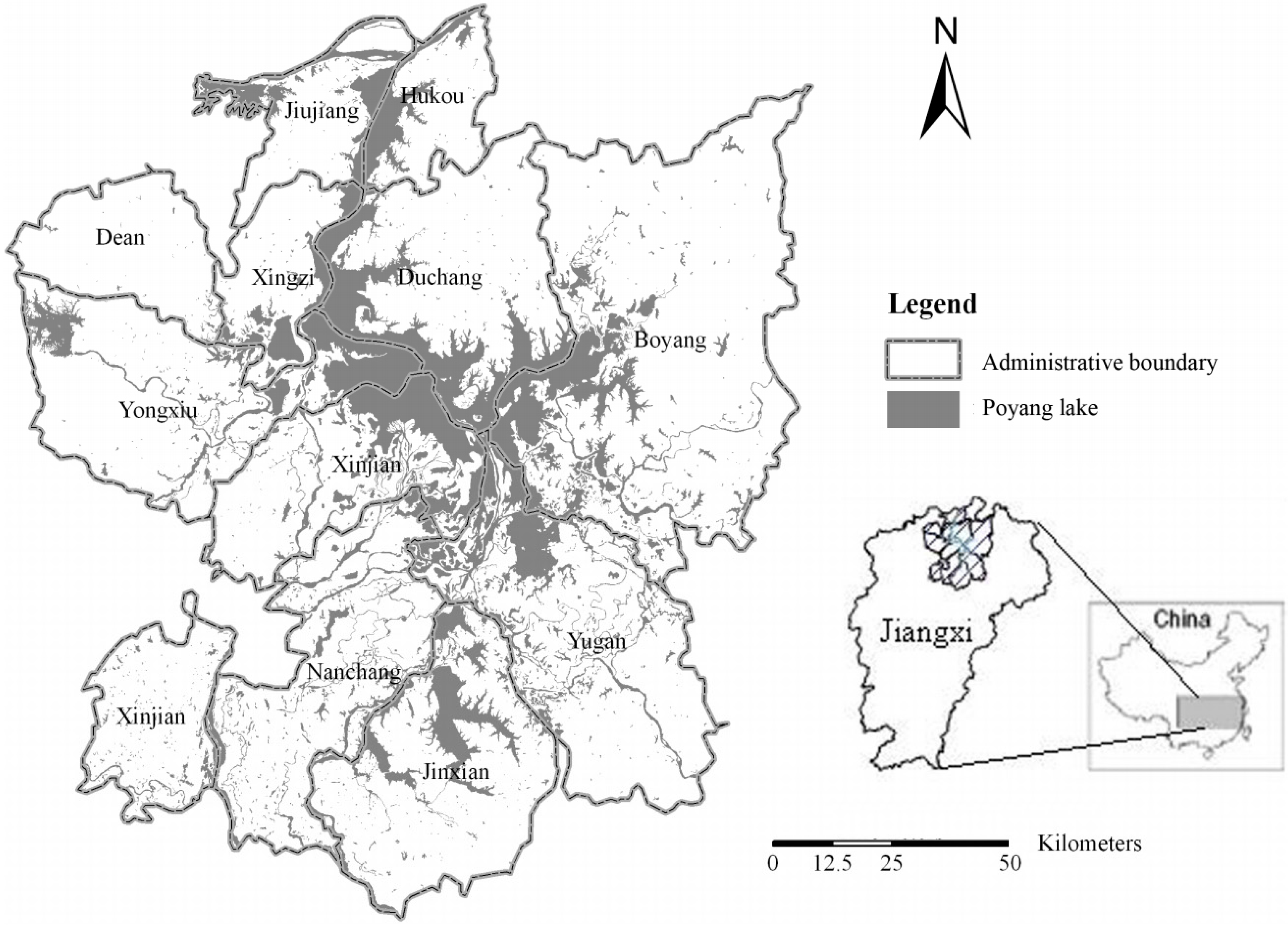
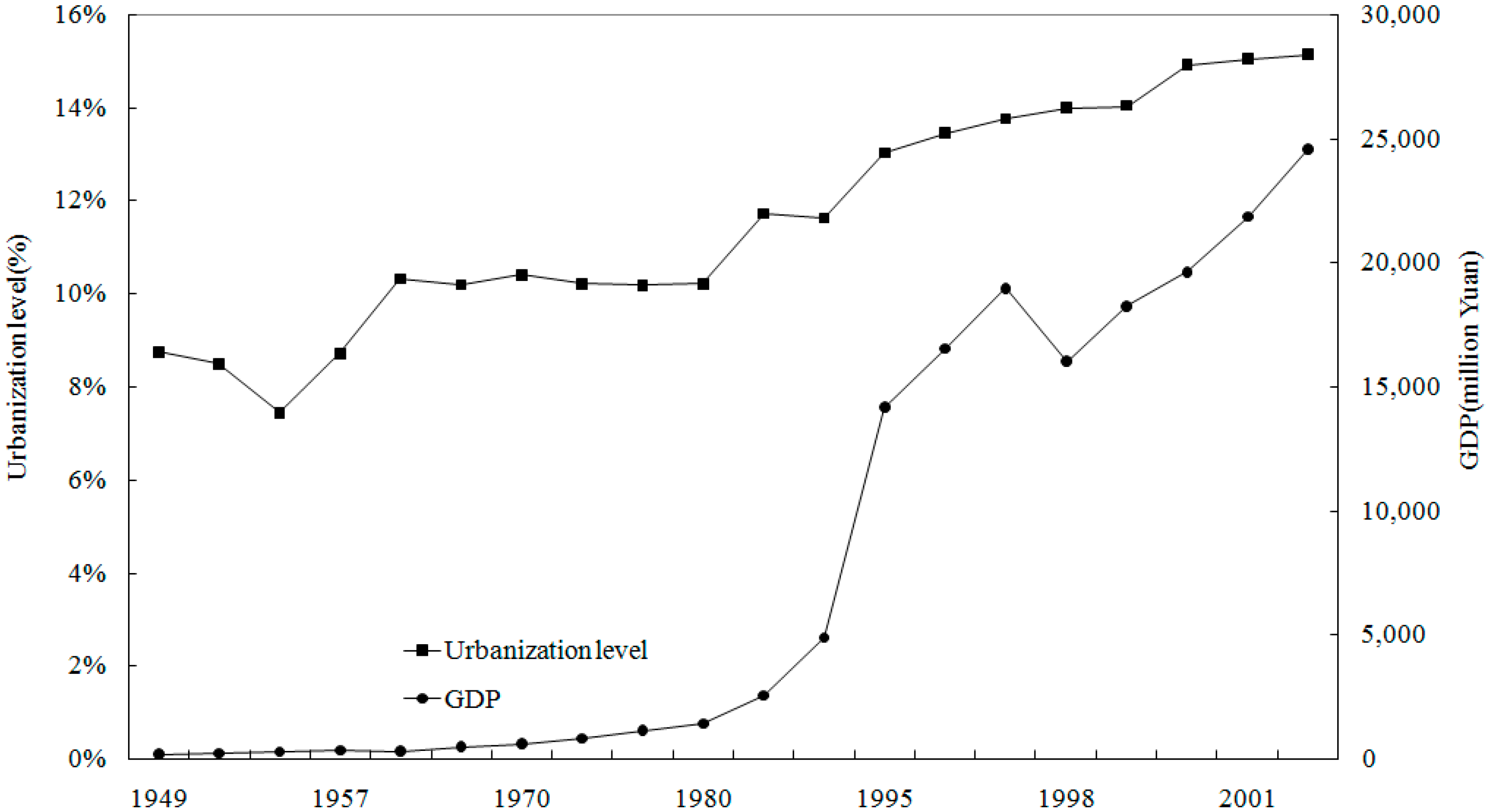
5. Results
5.1. Demand Prediction
5.2. Suitability Assessment
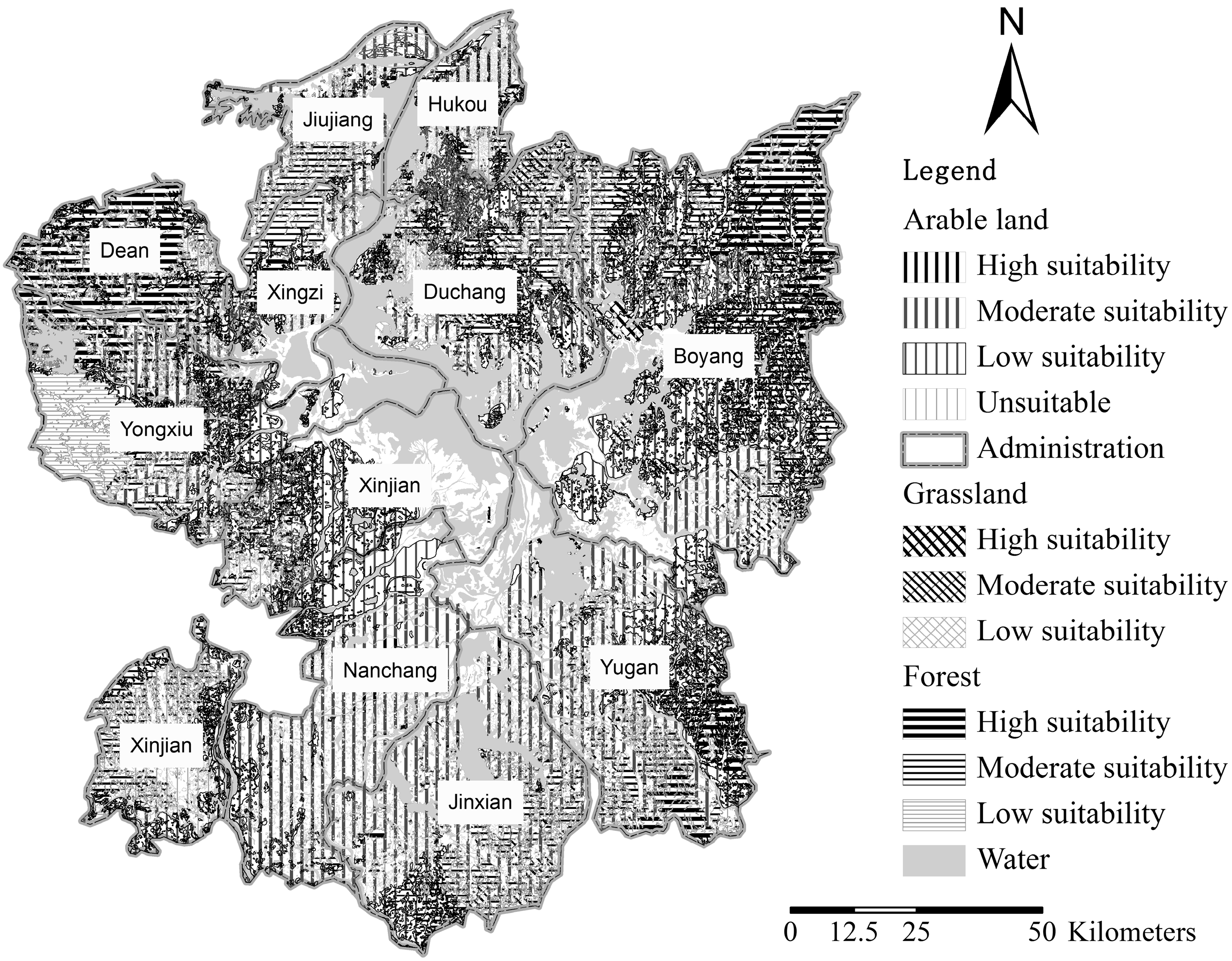
5.3. Single-Objective Pattern Optimization
| Land use | Area in 2005 | Food production scenario | Nature conservation scenario | Economic growth scenario | Area demand in 2015 |
|---|---|---|---|---|---|
| Arable land | 904,850 | 869,161 | 787,218 | 857,347 | 785,100 |
| Forest | 495,002 | 601,711 | 498,672 | 451,793 | 282,938 |
| Grassland | 69,559 | 69,559 | 192,339 | 68,347 | 16,8692 |
| Water body | 378,720 | 378,720 | 429,678 | 378,720 | 418,606 |
| Construction land | 50,627 | 50,627 | 50,627 | 143,050 | 69,900 |
| Non-developed land | 89,407 | 18,385 | 29,629 | 88,906 | - |
| Total | 1,988,163 | 1,988,163 | 1,988,163 | 1,988,163 | - |

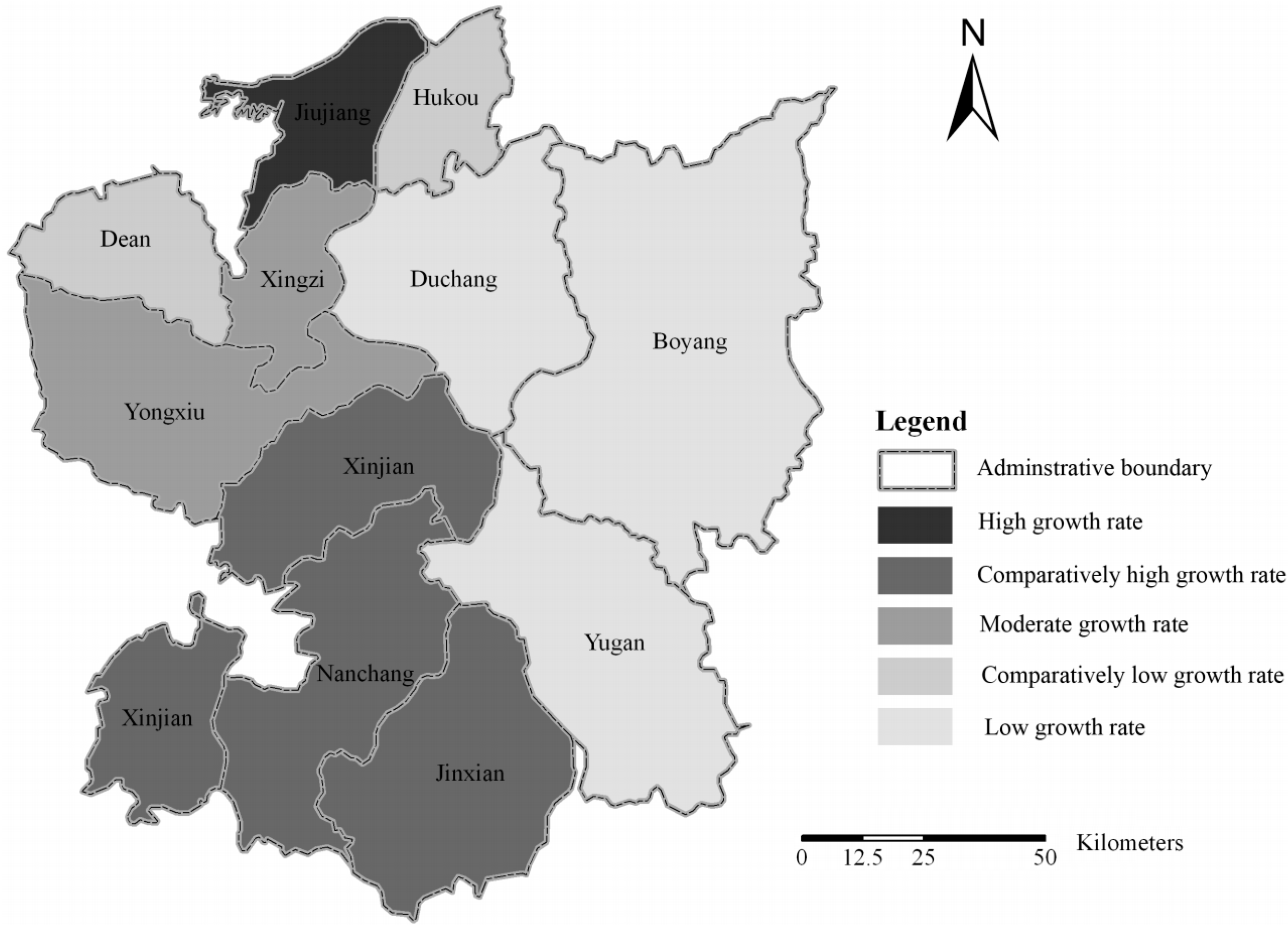
5.4. Multi-Objectives Pattern Optimization
| 2005 | Converted to | 2015 | |||||
|---|---|---|---|---|---|---|---|
| Arable land | Forest | Grassland | Water | Construction land | |||
| Arable land | 904,850 | - | 3862 | 92,401 | 8912 | 10,031 | 801,444 |
| Forest | 495,002 | 0 | - | 0 | 4776 | 191 | 496,031 |
| Grassland | 69,559 | 0 | 0 | - | 601 | 24 | 169,738 |
| Water body | 378,720 | 0 | 0 | 0 | - | 0 | 434,874 |
| Construction land | 50,627 | 0 | 0 | 0 | 0 | - | 69,838 |
| Non-developed land | 89,406 | 11,800 | 2135 | 8404 | 41,865 | 8964 | 16,238 |
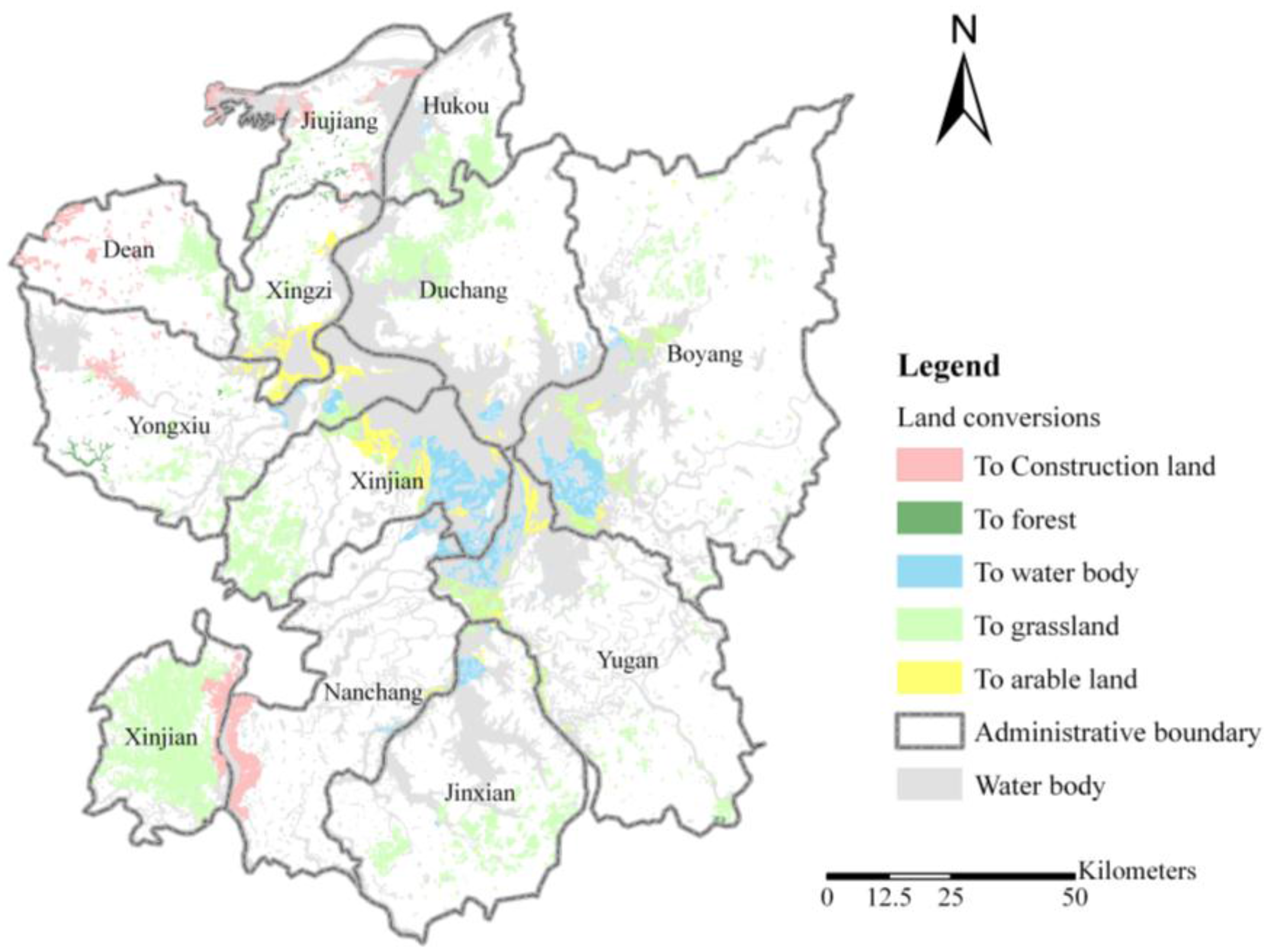
5.5. Assessment of the Results
6. Discussion and Conclusions
Acknowledgments
Author Contributions
Conflicts of Interest
References
- Schmidt, C.W. Economy and environment—China seeks a balance. Environ. Health Perspect. 2002, 110, A516–A522. [Google Scholar] [CrossRef] [PubMed]
- Kitada, T.; Okamura, K.; Tanaka, S. Effects of topography and urbanization on local winds and thermal environment in the Nohbi Plain, coastal region of central Japan: A numerical analysis by mesoscale meteorological model with a kappa-epsilon turbulence model. J. Appl. Meteorol. 1998, 37, 1026–1046. [Google Scholar] [CrossRef]
- Burak, S.; Dogan, E.; Gazioglu, C. Impact of urbanization and tourism on coastal environment. Ocean Coastal Manag. 2004, 47, 515–527. [Google Scholar] [CrossRef]
- Solecki, W.D.; Leichenko, R.M. Urbanization and the metropolitan environment—Lessons from New York and Shanghai. Environment 2006, 48, 8–23. [Google Scholar] [CrossRef]
- Li, Y.; Yeung, S.C.W.; Seabrooke, W. Urban planning and sustainable development under transitional economy: A case study of Guangzhou. Int. J. Sustain. Dev. World Ecol. 2005, 12, 300–313. [Google Scholar] [CrossRef]
- Song, Y.; Ding, C.R. Urbanization Challenges in China: Critical Issues in an Era of Rapid Growth. J. Ind. Ecol. 2011, 15, 816–816. [Google Scholar] [CrossRef]
- Chen, J. Rapid urbanization in China: A real challenge to soil protection and food security. Catena 2007, 69, 1–15. [Google Scholar] [CrossRef]
- Wang, X.; Guo, B.; Guan, X.J.; Wang, G. Urbanization and Food Crisis in China. Beyond Exp. Risk Anal. Crisis Response 2011, 16, 292–300. [Google Scholar]
- Ke, Z.; Xia, C.; Tan, B.P. Toward an improved legislative framework for China’s land degradation control. Nat. Resour. Forum 2008, 32, 11–24. [Google Scholar] [CrossRef]
- Lai, M. A comparative study on urban land use planning system between China and Taiwan. Sustain. City Urban Regen. Sustain. 2002, 14, 497–506. [Google Scholar]
- Tao, T.; Tan, Z.; He, X. Integrating environment into land-use planning through strategic environmental assessment in China: Towards legal frameworks and operational procedures. Environ. Impact Assess. Rev. 2007, 27, 243–265. [Google Scholar] [CrossRef]
- Michishita, R.; Jiang, Z.B.; Xu, B. Monitoring two decades of urbanization in the Poyang Lake area, China through spectral unmixing. Rem. Sens. Environ. 2012, 117, 3–18. [Google Scholar] [CrossRef]
- Chang, M.S.; Kung, C.C. Nonparametric Forecasting for Biochar Utilization in Poyang Lake Eco-Economic Zone in China. Sustainability 2014, 6, 267–282. [Google Scholar] [CrossRef]
- Chen, M.Q.; Wei, X.H.; Huang, H.S.; Lu, T.G. Poyang Lake basin: A successful, large-scale integrated basin management model for developing countries. Water Sci. Technol. 2011, 63, 1899–1905. [Google Scholar] [CrossRef] [PubMed]
- Deng, X.Z.; Zhao, Y.H.; Wu, F.; Lin, Y.Z.; Lu, Q.; Dai, J. Analysis of the trade-off between economic growth and the reduction of nitrogen and phosphorus emissions in the Poyang Lake Watershed, China. Ecol. Modell. 2011, 222, 330–336. [Google Scholar] [CrossRef]
- Food and Agricultural Organization (FAO). Guidelines for Land Use Planning; Food and Agricultural Organization of the United Nations: Rome, Italy, 1993. [Google Scholar]
- Arciniegas, G.; Janssen, R.; Omtzigt, N. Map-based multicriteria analysis to support interactive land use allocation. Int. J. Geogr. Inf. Sci. 2011, 25, 1931–1947. [Google Scholar] [CrossRef]
- Zhang, H.H.; Zeng, Y.N.; Bian, L. Simulating Multi-Objective Spatial Optimization Allocation of Land Use Based on the Integration of Multi-Agent System and Genetic Algorithm. Int. J. Environ. Res. 2010, 4, 765–776. [Google Scholar]
- Svoray, T.; Bar, P.; Bannet, T. Urban land-use allocation in a Mediterranean ecotone: Habitat Heterogeneity Model incorporated in a GIS using a multi-criteria mechanism. Landsc. Urban Plan. 2005, 72, 337–351. [Google Scholar] [CrossRef]
- Strange, N.; Meilby, H.; Thorsen, B.J. Optimization of land use in afforestation areas using evolutionary self-organization. Forest Sci. 2002, 48, 543–555. [Google Scholar]
- Brookes, C.J. A genetic algorithm for designing optimal patch configurations in GIS. Int. J. Geogr. Inf. Sci. 2001, 15, 539–559. [Google Scholar] [CrossRef]
- Verburg, P.H.; de Koning, G.H.J.; Kok, K.; Veldkamp, A.; Bouma, J. A spatial explicit allocation procedure for modelling the pattern of land use change based upon actual land use. Ecol. Model. 1999, 116, 45–61. [Google Scholar] [CrossRef]
- Chen, B.; Chen, G.Q. Ecological footprint accounting based on emergy—A case study of the Chinese society. Ecol. Model. 2006, 198, 101–114. [Google Scholar] [CrossRef]
- Antrop, M. Changing patterns in the urbanized countryside of Western Europe. Landsc. Ecol. 2000, 15, 257–270. [Google Scholar] [CrossRef]
- Carsjens, G.J.; van der Knaap, W. Strategic land-use allocation: Dealing with spatial relationships and fragmentation of agriculture. Landsc. Urban Plan. 2002, 58, 171–179. [Google Scholar] [CrossRef]
- Chen, L.D.; Messing, I.; Zhang, S.R.; Fu, B.J.; Ledin, S. Land use evaluation and scenario analysis towards sustainable planning on the Loess Plateau in China—Case study in a small catchment. Catena 2003, 54, 303–316. [Google Scholar] [CrossRef]
- Antrop, M. Landscape change and the urbanization process in Europe. Landsc. Urban Plan. 2004, 67, 9–26. [Google Scholar] [CrossRef]
- De Groot, R. Function-analysis and valuation as a tool to assess land use conflicts in planning for sustainable, multi-functional landscapes. Landsc. Urban Plan. 2006, 75, 175–186. [Google Scholar]
- Seppelt, R.; Voinov, A. Optimization methodology for land use patterns using spatially explicit landscape models. Ecol. Model. 2002, 151, 125–142. [Google Scholar] [CrossRef]
- Seppelt, R.; Voinov, A. Optimization methodology for land use patterns—Evaluation based on multiscale habitat pattern comparison. Ecol. Model. 2003, 168, 217–231. [Google Scholar] [CrossRef]
- Koomen, E.; Rietveld, P.; de Nijs, T. Modelling land-use change for spatial planning support. Ann. Reg. Sci. 2008, 42, 1–10. [Google Scholar] [CrossRef]
- Yin, R.S.; Xiang, Q.; Xu, J.T.; Deng, X.Z. Modeling the Driving Forces of the Land Use and Land Cover Changes Along the Upper Yangtze River of China. Environ. Manag. 2010, 45, 454–465. [Google Scholar] [CrossRef]
- Joerin, F.; Theriault, M.; Musy, A. Using GIS and outranking multicriteria analysis for land-use suitability assessment. Int. J. Geogr. Inf. Sci. 2001, 15, 153–174. [Google Scholar] [CrossRef]
- Liu, Y.S.; Wang, J.Y.; Guo, L.Y. GIS-based assessment of land suitability for optimal allocation in the Qinling Mountains, China. Pedosphere 2006, 16, 579–586. [Google Scholar] [CrossRef]
- Kessler, J.J. Usefulness of the Human Carrying-Capacity Concept in Assessing Ecological Sustainability of Land-Use in Semiarid Regions. Agric. Ecosyst. Environ. 1994, 48, 273–284. [Google Scholar] [CrossRef]
- Ye, L.M.; van Ranst, E. Population carrying capacity and sustainable agricultural use of land resources in Caoxian County (North China). J. Sustain. Agric. 2002, 19, 75–94. [Google Scholar] [CrossRef]
- Liu, M.; Hu, Y.; Li, X.; He, H.S.; Xu, C.; Zhang, W. Ecological footprint and biological capacity time series assessment for a forest region in northeastern China. Int. J. Sustain. Dev. World Ecol. 2007, 14, 493–502. [Google Scholar] [CrossRef]
- Wackernagel, M.; Onisto, L.; Bello, P.; Linares, A.C.; López Falfán, I.S.; Méndez Garcı́a, J.; Guerrero, A.I.S.; Guerrero, M.G.S. National natural capital accounting with the ecological footprint concept. Ecol. Econ. 1999, 29, 375–390. [Google Scholar] [CrossRef]
- Monfreda, C.; Wackernagel, M.; Deumling, D. Establishing national natural capital accounts based on detailed - Ecological Footprint and biological capacity assessments. Land Use Policy 2004, 21, 231–246. [Google Scholar] [CrossRef]
- Food and Agricultural Organization (FAO). A Framework for Land Evaluation. Soils Bulletin 32; Food and Agricultural Organization of the United Nations: Rome, Italy, 1976. [Google Scholar]
- Blaschke, T. The role of the spatial dimension within the framework of sustainable landscapes and natural capital. Landsc. Urban Plan. 2006, 75, 198–226. [Google Scholar] [CrossRef]
- Cui, L.J.; Wu, G.F.; Liu, Y.L. Monitoring the impact of backflow and dredging on water clarity using MODIS images of Poyang Lake, China. Hydrol. Process. 2009, 23, 342–350. [Google Scholar] [CrossRef]
- Feng, L.; Hu, C.M.; Chen, X.L.; Li, R.F. Satellite observations make it possible to estimate Poyang Lake’s water budget. Environ. Res. Lett. 2011. [Google Scholar] [CrossRef]
- Carsjens, G.J. Supporting Strategic Spatial Planning: Planning Support Systems for the Spatial Planning of Metropolitan Landscapes. Ph.D. Thesis, Wageningen University, Wageningen, The Netherlands, 2009. [Google Scholar]
- Geertman, S.; Stillwell, J. Planning Support Systems: Best Practice and New Methods; Springer Science: Berlin, Germany, 2009. [Google Scholar]
- Brail, R.K. Planning Support Systems for Cities and Regions; Lincoln Institute of Land Policy: Cambridge, MA, USA, 2008. [Google Scholar]
- Buono, F.; Pediaditi, K.; Carsjens, G.J. Local community participation in Italian national parks management: Theory versus practice. J. Environ. Policy Plan. 2012, 14, 189–208. [Google Scholar] [CrossRef]
- Institute of Environmental Management and Assessment (IEMA). Perspectives, Guidelines on Participation in Environmental Decision Making; IEMA: Lincoln, UK, 2002. [Google Scholar]
- Wu, J.; Fox, J.B.; Donohue, J.M.; Dai, Q. An empirical study of land reallocation management and peasant loss of lifetime employment: Societal unrest in China through the lens of organisational justice research. Int. J. Sustain. Soc. 2010, 2, 50–69. [Google Scholar] [CrossRef]
© 2014 by the authors; licensee MDPI, Basel, Switzerland. This article is an open access article distributed under the terms and conditions of the Creative Commons Attribution license (http://creativecommons.org/licenses/by/4.0/).
Share and Cite
Chen, W.; Carsjens, G.J.; Zhao, L.; Li, H. A Spatial Optimization Model for Sustainable Land Use at Regional Level in China: A Case Study for Poyang Lake Region. Sustainability 2015, 7, 35-55. https://doi.org/10.3390/su7010035
Chen W, Carsjens GJ, Zhao L, Li H. A Spatial Optimization Model for Sustainable Land Use at Regional Level in China: A Case Study for Poyang Lake Region. Sustainability. 2015; 7(1):35-55. https://doi.org/10.3390/su7010035
Chicago/Turabian StyleChen, Wenbo, Gerrit J. Carsjens, Lihong Zhao, and Haifeng Li. 2015. "A Spatial Optimization Model for Sustainable Land Use at Regional Level in China: A Case Study for Poyang Lake Region" Sustainability 7, no. 1: 35-55. https://doi.org/10.3390/su7010035
APA StyleChen, W., Carsjens, G. J., Zhao, L., & Li, H. (2015). A Spatial Optimization Model for Sustainable Land Use at Regional Level in China: A Case Study for Poyang Lake Region. Sustainability, 7(1), 35-55. https://doi.org/10.3390/su7010035





